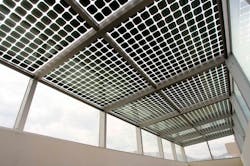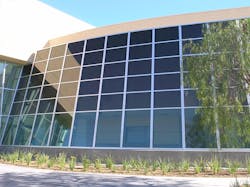Solar panels have produced green energy on the rooftops of homes and commercial buildings for decades. An evolving building practice, however, integrates the photovoltaic (PV) elements into the building envelope — transforming the structure into a generating asset.
Through building-integrated photovoltaics (BIPV), a specialized construction team replaces traditional materials for rooftops, awnings, windows, and facades with PV modules. For example, electricians are working alongside glaziers, solar technicians, roofers, architects, and engineers to install solar shingles on roofs, PV elements in curtainwalls, facades, and windows, and solar canopies atop parking garages.
Globally, this market has grown from 1.5GW in 2014 to 2.3GW in 2015. By 2020, it is forecast to reach 11.1GW, according to the Development of Innovative Educational Material for Building-Integrated Photovoltaics (Dem4BIPV).
While the market has grown globally, it still faces major challenges domestically, which is slowing down widespread adoption of BIPV, says Steven Strong, president of Harvard, Mass.-based Solar Design Associates, an engineering and architecture firm dedicated exclusively to renewable energy.
“It has done remarkably well in terms of becoming more sophisticated and going up in scale,” says Strong, whose firm designed the first fully integrated solar electric residential system — the Impact 2000 House — back in the 1980s. “Most of the progress, however, has occurred outside of the United States.”
Overcoming obstacles
One roadblock standing in the way of the BIPV market in the United States stems from the focus on codes and standards, says Christopher Klinga, professional engineer and technical director for the Architectural Solar Association (ASA). The current standards are more focused on traditional, non-integrated solar modules, and reference BIPV in a loose way. As such, it creates a lot of room for interpretation on how BIPV products should be tested, Klinga says. Because BIPV products can be integrated into the building envelope, however, they can have different testing constraints.
“The codes and standards still need to be developed,” Klinga says. “As a result, some builders are leery of incorporating BIPV into buildings.”
The construction industry follows the IEC certification in Europe, where the products come in several different sizes, and it’s easier to get a range of products certified, Klinga says. State-side, however, the products must abide by the UL 1703 standard, which makes it costly to obtain certification for a range of products.
To overcome this issue, suppliers typically seek project-specific certification for BIPV. But obtaining a customized project-specific certification can cost anywhere from $10,000 to $50,000. As a result, BIPV quickly gets value engineered out to keep costs down, Klinga says. More companies are expanding their UL product certifications to encompass a range of product sizes, but this is a very costly endeavor and a large barrier to entry.
Currently, both the building integrated component itself and the supporting structure must be listed by UL. For example, in the case of a curtainwall facade, the solar modules and metal structure must be tested and approved by UL.
“The codes and standards for approving photovoltaic modules for sale in the United States are a bit archaic,” Strong says. “Each individual component has to go through a fairly rigorous testing process by UL before it is manufactured and sold. That has been a drag on advancing BIPV into larger scale architectural projects within the United States.”
To help to overcome this obstacle, the National Renewable Energy Laboratory (NREL) has been working to harmonize the international standards so the European, Asian, and American standards become a common requirement. That way, the manufacturers don’t need to make multiple product lines to meet the needs of different geographical markets.
“There has been a concerted effort to standardize the requirements, and hopefully that will allow the BIPV manufacturers, who are flourishing in Europe and Asia, to access the U.S. market,” Strong says. “By collaborating with the countries in the European Union and Asia, we hope to come to an international consensus.”
In addition to being challenged by regulations, the financial aspect of the BIPV market also provides barriers.
“We have to make sure that the financing mechanisms are mature enough to see BIPV as an opportunity,” Klinga says. “The solar industry can attribute a great deal of growth to the advent of the Power Purchase Agreement (PPA), which is difficult to apply to the building-integrated space because BIPV can encompass the entire building envelope. This poses additional liability outside the scope of a typical PPA. Providers of PPAs have a hard time wrapping their heads around how to finance these projects.”
One major benefit of BIPV is that federal tax credits and accelerated depreciation have the potential to apply to a component of the building envelope. In other more traditional construction projects, however, this is not the case.
Stan Pipkin, vice president of Lighthouse Solar, a full-service integrator that handles everything from design through system integration, has noticed a gap between professional service needs and the willingness of the market to pay for it. Right now, he says because solar is undervalued, most architects and engineers won’t provide the service, and building owners may shy away from BIPV due to the challenges.
Another obstacle centers around building integration. Specifically, the building industry is still trying to figure out ways to synchronize solar integrators and electricians with the building envelope provider, which could take time, Klinga says.
Finally, BIPV faces a challenge when it comes to the payback, which is often more lucrative when solar is optimally configured. For example, residential sloped roofs or even facades aren’t always the best location or orientation for solar in terms of energy harvest, he says.
“When you have acute angles of incidence, you’re not getting a dramatic amount of power from the investment,” Strong says. “BIPV is typically more expensive than non-integrated solar, which is configured specifically to face the sun. When it comes to return on investment, BIPV is not often at the top of the list.”
Taking a team approach
These unique projects require the building industry to collaborate with solar integrators and electrical contractors from the start, Klinga says.
“It’s critical for builders to directly involve electricians with the system design as well as the integration,” Klinga says. “They must start a dialogue with the trades in order to do this kind of work.”
While other trades or disciplines can place the BIPV components, electrical contractors or electricians must perform the actual wiring and electrical installation and termination in most states. For example, in certain areas, where local rebates are tied to production credits, solar or electrical contractors must be involved.
“It varies from jurisdiction to jurisdiction,” Klinga says. “While it’s common practice for solar installers and electrical contractors, it’s not something that the façade manufacturers and the designers are used to. Finding a way to bridge the trades is critical for BIPV success.”
Klinga recommends that general contractors engage electrical and solar contractors from the start, regardless of whether or not they are required to do so. If they don’t, they may have to face costly change orders or turn to value engineering, he says.
“BIPV typically impacts the critical path of a building’s construction schedule; therefore, it is necessary to involve the relevant parties from the start of the design process,” Klinga says.
For example, Lighthouse Solar, an electrical contracting firm in Austin, Texas, captured a share of the solar market by filling a specialized niche within the market. With its in-house team of project developers, architects, and PV designers, the firm can more readily work with a BIPV project team of architects and engineers.
“One reason why we have been successful in working with the architecture profession is we understand their business process,” Pipkin says. By having a design team inside of our electrical contracting firm, we have moved beyond the installation company model.”
Other commercial electrical contracting firms can also leverage opportunities in the BIPV market if they can bring the right people to the right table at the same time, he says.
“Within the commercial space, there are many project owners who are thinking about integrated solutions, which rely on precise design information for electrical equipment integration,” Pipkin says. “The commercial electrical contractors often have more experience than solar firms on commercial building electrical design and best practices.”
To truly be successful in the BIPV market, however, electrical contracting firms must be prepared to converse about BIPV and speak the same language as system providers and glaziers. At this point in time, Pipkin says most of the opportunities generated in BIPV are stemming from a collaboration between the solar company, electrical engineer, and architect. As such, the electrical contractors are not part of the process until everything is specified.
“Most of the time, I see notes on a drawing that say ‘solar system by others,’ and then the electrical contracting firm has to figure everything out,” Pipkin says. “This is no longer a building-integrated approach.”
Because architects, designers, and developers are now considering solar much earlier in a project, Lighthouse Solar can reap the benefits of the building-integrated approach without being limited to BIPV products.
“Solar has become part of the design process rather than an afterthought,” Pipkin says.
When Lighthouse Solar first entered the BIPV industry, however, BIPV was a pipe dream dominated by large, institutional projects, Pipkin says. At that point, the projects were very aspirational, and the developers and owners were focused on trying to replace a wall, roof, or skylight with a PV element integrated into the building envelope.
“We didn’t have any traction in that at all, and we didn’t see any of that happening in the United States due to the cost, complexities, and immature integration technologies,” Pipkin says.
Fast forward eight years, and the contractor focuses more on an integrated design and process approach rather than building integration. Today, Pipkin defines BIPV as solar being integrated into the design process, which is one of the biggest hurdles.
“Whether it ends up replacing the façade or roof is immaterial,” Pipkin says. “If it is integrated into the design process, it cannot be value engineered out, which typically happens. This way, solar is not an easy thing to scratch off.”
Installing the latest technology
In the future, Strong sees potential for widespread applications within the United States. While he says the U.S. market isn’t currently as exciting as Europe or Asia, it’s a great way to show off green technology.
“BIPV is one of the largest visual cues that a building is green or sustainable,” Strong says. “This has been a large motivator for the projects around the world. It makes a very clear public statement.”
The real opportunity for BIPV, Strong says, lies not in the residential but the commercial market.
“Commercial structures allow the architects freedom of expression to show off the technology,” Strong says. “I think the future for BIPV is in commercial architecture.”
At this point in time, Klinga considers window shades, overhead canopy structures, and carport applications to be the low-hanging fruit in the BIPV market.
“I think there are a lot of opportunities for electrical contractors and solar integrators to be involved in this process,” he says. “They don’t necessarily enclose the building envelope, but they meet the definition of BIPV — which is that solar is multifunctional and serves as a building component as well as a power-generating photovoltaic element.”
Since these projects require less customized module sizes, Klinga advises electrical contractors to focus on these types of projects until more customizable BIPV products become available. Once that happens — and products start to integrate more with the building façade — architects and façade designers can engage with electrical and solar installers on the full integration into the envelope.
On the residential side of the market, electrical contracting firms can work with roofing companies to install solar shingles or tiles, which have been commercially available for many years. Right now, however, these products have had a hard time gaining acceptance in the residential solar space, which is mainly driven by a solar-lease model.
“It’s been difficult to convince the providers that integrating PV into the roof structure is a liability worth taking on,” Klinga says. “It’s not to say that they are unreliable, but there is less confidence associated with them because they have less of a track record and now encompass additional liability.”
Although BIPV roof shingle replacement systems have drummed up some enthusiasm within the United States, Strong says they are not always a good idea.
“You have to hook up many of them in a series, and they’re like the old Christmas lights — if one fails, they all go out,” Strong says. “They are also hard to troubleshoot because all of the connections are under the roof surface, and you often can’t access them from the attic. Instead, you have to deconstruct a large part of the roof to test these components.”
In addition, Strong says another challenge is that if a roof shingle or tile fails, how can a homeowner get new replacement materials in 10, 15, or 20 years? He says it’s impossible to expect a manufacturer to make a certain model that far in the future.
“We’ve pioneered the building integrated approach in the United States and have been doing this for over three decades,” Strong says. “During that time, we have seen many companies come and go, and components fail with no replacements available. We always recommend our clients purchase some ‘attic stock’ for every system we specify to address future requirements.”
Learning about solar
To take on BIPV projects, an electrical contracting company needs to have the solar training credentials and aptitude to work with not only AC, but also DC electrical systems. In many cases, a solar installer, or even a roofing company, may hire licensed electricians to install and wire the BIPV modules within a structure, but they handle the rest of the installation work.
For electrical contracting companies interested in pursuing opportunities in the BIPV market, they must gain a baseline level of solar knowledge and learn about the tools they will need to perform work in this market, Klinga says.
“There isn’t anything incredibly unique to BIPV that you need specialized training for,” Klinga says. “The first step is for electrical contractors to gain a general solar awareness.”
Strong estimates approximately 75% of the requirements are the same between non-integrated solar and BIPV. From an electrical standpoint, the one key difference is that the connections are often hidden, especially in residential roofing and commercial façade applications.
“The whole idea of BIPV is you want it to be clean so you don’t see any visible wires,” Strong says. “As a result, the electrical connections are behind or underneath the waterproof, weathering skin of the structure. The challenge for electrical contractors is to find a way to make connections accessible for servicing and conform to the requirements of the National Electrical Code.”
Although electrical contractors may likely be involved in the electrical installation of non-integrated PV systems, BIPV elements will probably be installed by, or in cooperation with, other trades. Case in point: Rather than electricians installing solar glass, façade installers will most likely perform this kind of work. This is especially the case when the PV elements are actually integrated into the building envelope as the weathering skin.
“If a general contractor needs a warranty on the building envelope, the solar installers and electrical contractors won’t want to take on that liability, and I don’t believe that the building industry would necessarily let them,” Klinga says. “General contractors aren’t going to trust electricians to glaze in a piece of photovoltaic glass.”
Strong agreed, saying glazing contractors are able and willing to provide a waterproof warranty if the waterproof skin of the solar system leaks or there are condensation issues in a cold climate.
“Even if electrical contractors want to take on the installation work, they are typically not equipped to perform the glazing work,” Strong says. “It provides somewhat of a quandary. Oftentimes, they hire glaziers to do that part of the work, and then they handle the wiring, power electronics, and the interface to the electric utility.”
BIPV provides opportunities for electrical contracting companies if they work to make the opportunities happen. For example, Pipkin says contractors need to provide consulting, hire a design team, switch up their business model, and go beyond marketing their installation services.
“There are very few people doing it, and if contractors are interested in solar — and they can bring their experience — there is an opportunity there,” Pipkin says. “It’s not a given, however, and it will not happen unless individual contractors continue to push it forward.”
Editor’s Note: Architectural Solar Association recently sponsored a webinar titled, “Global Business Opportunities for Architectural Solar (BIPV).” To access the archived webinar, visit https://goo.gl/1vtMIW for for more information, visit ASA at www.archsolar.org.
Fischbach is a freelance writer based in Overland Park, Kan. She can be reached at [email protected].




